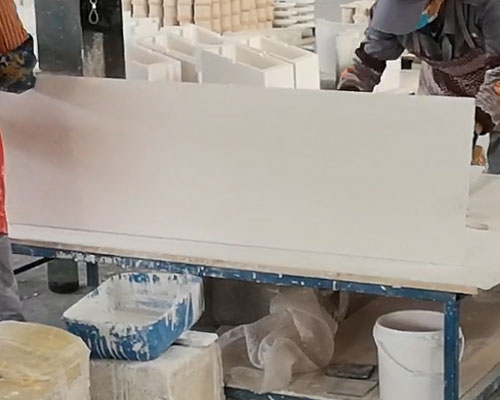The continuous caster feed tip is made of refractory fiber felt, which contains approximately equal amounts of alumina and silica, and contains a solution containing colloidal silica. The typical composition of the fiber is about 51.2% alumina, 47.4% silica and about 0.7% boron oxide and sodium oxide.
To make a suitable felt, these fibers are dispersed in an aqueous solution containing a dispersion of colloidal silica. By diluting the obtainable composition, the composition contains about 30% by weight of colloidal silica solids. The average particle size of colloidal silica is about 17 microns or an average of about 48 silicon atoms per particle. Colloidal silica is stabilized in solution by sufficient alkali metal hydroxides such as sodium hydroxide or lithium hydroxide to reach a pH of about 9.5 to 10.5. The composition was diluted with water to form a solution containing about 22% by weight solids of colloidal silica. Sufficient refractory fibers are dispersed in the solution to form a slurry with about 5 wt% fibers.
This slurry is formed into a blanket or mat of refractory fibers through a conventional felting operation. Dip the porous felt mesh into the slurry and connect the bottom surface to the vacuum cleaner. The fibers accumulate on the surface of the screen to form a mat, which is preferably up to about 2 1/2 cm thick. The felt thus formed maintains suction so that the liquid content of the pad is reduced to about 20% by weight and the colloidal silica content is reduced to about 5% by weight. A felt formed by vacuum felting from a slurry of refractory fibers is used to form a part of the molten metal feed tip of a continuous casting machine.

To form the continuous caster feed tip, cut out a rectangle of appropriate size for this refractory felt. To form part of the feed tip, cut a rectangle about 15 cm wide and 23 cm long from a 1-inch thick blanket. Smooth a rectangular fiberglass cloth with the same size as the blanket on one surface of the blanket. Preferably, the fabric is tightly woven so that there is no open space through the weaving. An unsized glass fabric is used on the surface, and the commercially available glass fabric is preferably cleaned of sizing material before attaching to the felt. The sizing can be removed, for example, by baking the glass fabric at about 250°C for half an hour.
Cover the other side of the felt with a thin piece of aluminum foil. Foil of 1/4 to 1/2 mm thick is suitable. You can leave some “observation holes” in the aluminum foil to draw liquid from the blanket.
Then the refractory blanket laminated with glass fiber and aluminum foil is placed in the mold cavity, and the cavity is closed with a matching mold. Then, the assembly is compressed with insufficient pressure to break the fibers to compress the felt to the desired geometry of a portion of the continuous caster feed nozzle. Allow excess liquid in the closed mold to be discharged through a suitable discharge hole in the closed cavity.
When the cover layer of refractory fibers is compressed in a closed mold cavity, it is preferable that the maximum compression in the die is less than about 85% of the original thickness of the vacuum sintered cover layer. If the compression is greater than about 85% of the original thickness, excessive crushing and fracture of the refractory fiber may occur, resulting in a significant decrease in the strength of the compressed material.

